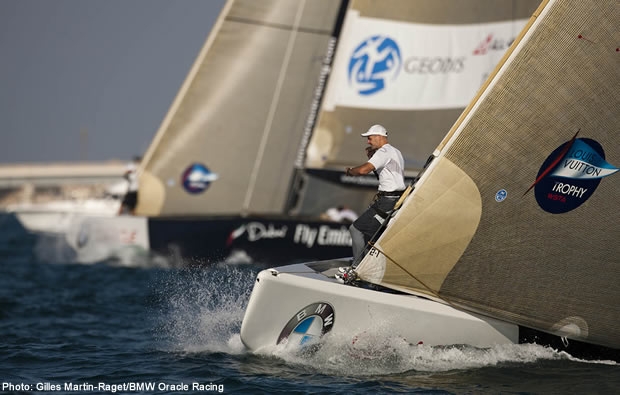
The end of an era
Unless some mad fool decides to buy them all up, the America’s Cup Class monohulls, used to contest the ‘Auld Mug’ from 1992 until 2007 sailed their final race last Saturday at the Louis Vuitton Trophy Dubai. The demise of the ACC comes at the same time as the berth of the 100 year old Star’s place in the 2016 Olympic Games is under threat with the keelboat failing to get selected as an event for Rio, subject to a final decision next year. It seems that we are at the end of an era – not just that of another genre of America’s Cup boat, but it could be that historians of the future will look back on 2010 as the year that marked the death of the heavyweight keelboat.
Being a fan of fast lightweight boats, the AC45 and AC72 wingsail cats being among the most extreme examples, we are personally not sorry to see this trend. While multihulls have pretty much always been lightweight machines capable of huge speed, with monohulls the move to lightweight – or ideally variable displacement, like the IMOCA Open 60s - has been some 30 years in coming. While the largely French offshore monohulls such as the Open 60s are a case apart, the thrills and spills of lightweight monohulls have been demonstrated since the early 1990s across the globe in sportsboats starting with the likes of the J/80 and Melges 24 up to the most recent Melges 32. This trend has filtered through to most areas of monohull sailing and even into cruising boats with a couple of exceptions such as the Volvo 70 which has been allowed to get heavier for the next round the world race (wrongly so in our view) and specialist match racing boats such as the Elliott 6. Aside from the Elliott can anyone remember the last production boat sold with a spinnaker pole? Your answers below please.
For this move to faster boats is having an effect on monohull racing that spreads to how boats are equipped, the disappearing of the spinnaker pole and symmetric kites being the most obvious example, to how faster boats are most successfully raced.
The question is – what are we going to lose by this move to fast boats? The powerful Star lobby, who’s case we’ll be putting next week, have strong views about it and as anyone who has sailed on an America’s Cup Class boat will attest, these pencil thin super heavyweight 85 footers represent a pretty much unique challenge to sail, including a monster team effort required from the 17 crew to get them around the course. Heavy race boats such as these require more sail to drive them and this in turn means substantially greater loads and a more thorough work-out for the crew.
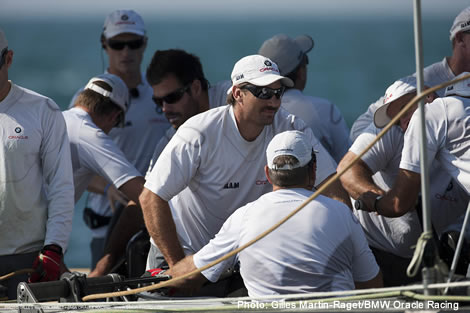
There is the argument that it actually takes more skill and tweaks to successfully negotiate a relatively slow heavy boat around a race course than the more ‘lock and load’ approach to say multihull racing where it is more down to the helmsman steering to the sail trim rather than vica versa. Another view is that faster boats don’t produce closer racing.
Here some top gentleman in our sport air their views on the demise of the ACC and what it means:
Murray Jones
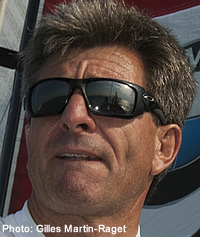 New Zealander Murray Jones is one of the select few, including Brad Butterworth, Warwick Fleury, Simon Daubney and Dean Phipps, who made the transition from Team New Zealand to Alinghi that allowed them an unbroken string of America’s Cup wins between 1995 and 2007. Now Jones is back with Russell Coutts at BMW Oracle Racing.
New Zealander Murray Jones is one of the select few, including Brad Butterworth, Warwick Fleury, Simon Daubney and Dean Phipps, who made the transition from Team New Zealand to Alinghi that allowed them an unbroken string of America’s Cup wins between 1995 and 2007. Now Jones is back with Russell Coutts at BMW Oracle Racing.
You don’t sail many boats these days with spinnaker poles? “I think it is the end of an era. I’m sure in five years time you won’t find a boat with a spinnaker pole. Our kids will be going ‘what we were doing having one of those?’”
Are there some skills we’ll lose with the demise of the ACC class? “A boat like this requires a lot of people to handle it and there are a lot of jobs to do – a gybe and a drop with a spinnaker pole adds a lot of tasks and it therefore requires pretty good team work and split second timing between everyone and that is really what makes the racing what it is. And that is enjoyable – the team aspect of the sport. If you go for a lightweight simple boat in some ways some of those things will disappear, but as long as you don’t have too many crew on board then it is fine as well. I was disappointed that when they sail these light weight boats, like the TP52 and the Mini Maxis, they have 15-20 people on them and five people don’t do anything. The other extreme is the Volvo 70, which I think is very light handed as far as crew is concerned: it is incredibly demanding and that is great! That is how it should be!”
The tactical side changes sailing faster boats – you look more for pressure than shifts (Jones is often consigned up the rig as wind spotter during racing)? “Yes, but you are still reading the wind and you are still using the same skills and it doesn’t really change. With these boats you need full sail to power them up. With the light boat you will be depowering very quickly. It is using the same skills I think, just different techniques.”
Heavy monohulls have a future? “I honestly think they will disappear and we’ll go to fast boats.”
John Cutler
 New Zealander John Cutler has been sailing ACC boats since they were introduced, initially as Chris Dickson’s tactician on Nippon Challenge in 1992. Subsequently he went through America True to Oracle BMW Racing (as they were called in 2003) and then on to the Spanish Desafío Español team in Valencia. Most recently he has been sailing as tactician with the Franco-German All4One team.
New Zealander John Cutler has been sailing ACC boats since they were introduced, initially as Chris Dickson’s tactician on Nippon Challenge in 1992. Subsequently he went through America True to Oracle BMW Racing (as they were called in 2003) and then on to the Spanish Desafío Español team in Valencia. Most recently he has been sailing as tactician with the Franco-German All4One team.
“It is a bit sad in some ways, but it is 20 years and it is time to move on. These [ACC] boats have done their time and they have achieved what they set out to do which was close match racing - you’d sail with your opposition a boat length or so behind you all day and small errors in crew work or tactics get punished in these boats.”
There are not many other boats which require such huge crew effort? “If you look at the Mini Maxis, it is probably about the same, they are just lighter displacement. There is a lot more crew kinetics, and downwind you are suddenly on the plane doing 20 knots, but those boats just aren’t developed to the same degree. We have done year after year of two boat testing on these things [ACC boats] and each team has built two boats in a two or three year campaign and they are a steady refinement on a pretty stable class rule.”
The end of an era? “I think so for sure. When we were looking to come up with a boat for the previous Cup [the AC90 and AC33], before all the disaster happened and we were all sitting in a room, it was like ‘if we need a spinnaker pole, we have probably designed the wrong boat’. That was the fundamental statement. So it had to be light displacement and had to sail with fairly narrow apparent wind angles, so that you could set a genniker without a spinnaker pole. If you look at the TP52 – they have jettisoned the pole, got rid of two crew and made the boat lighter and we have made it lighter again this year as well. Now the boat is just brilliant to sail downwind and all the hassle of pushing the pole out and back in – it’s all gone.”
What are we losing in the process? “We are losing mastmen and some of the techniques, like squaring the pole and running with a spinnaker, but the boats are quite nice. The TP52, the STP65s and the Mini Maxi - they scoot along downwind and you cover a lot of ground. It is quite fun. You are on a 68 footer and you are doing 20 knots surfing along, everyone hiking behind the helmsman. It is a pretty nice step forward, whereas you take one of these [ACC boats] in 20 knots and you have got the pole back, you are digging a big hole, everyone is nervous because the loads get higher and higher. But for match racing these have been brilliant.”
Do faster boats require less skill to race? “Just different skills. Everyone needs to be more agile, when a puff hits you just have to hike out, but on this [ACC boat] what are we going to do? The boat is only so wide. On a new boat you have to hike. The bow goes in a wave and you have to move aft, so everyone has got to move and do their job. I think in fact it is more in keeping with where we all came from – dinghies - where your body and everything was more together. So I think we have made a few steps forward. So these things have done their time and it is 20 years I have sailed them and I have enjoyed it. But now it’s catamarans.”
Paul Cayard
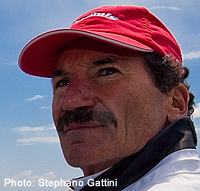 Paul Cayard needs little introduction and of course he too was involved with the ACC class from the outset skippering Il Moro de Venezia into the challenger berth in 1992. He now is CEO of Tornbjorn Tornqvist’s Swedish Challenger, Artemis Racing.
Paul Cayard needs little introduction and of course he too was involved with the ACC class from the outset skippering Il Moro de Venezia into the challenger berth in 1992. He now is CEO of Tornbjorn Tornqvist’s Swedish Challenger, Artemis Racing.
Sorry to see the ACC boats go? “They did produce a certain type of racing. The racing was generally pretty close in proximity, but people mistake that for a good race. The truth of the matter is that having a two or a three boat length lead in these boats, with good boat handling and staying close to the guy it is really hard to pass. As we know from Valencia in 2007, the statistics were something like - the boat that gets to the weather mark first wins 85% of the time and if he is at the leeward mark first he wins 92% of the time, so there wasn’t a lot of passing going on. I think the multihull thing – there is a lot more variability there, I think there will be huge speed differences between a boat that is gybing or tacking and one which is doing full speed in a straight line at 30 knots. And if you pooch the manoeuvres you are really going to lose a lot of distance.”
As to spinnaker poles being consigned to history, Cayard says: “I often joke about that and say my son will go ‘my dad – he used to race with spinnaker poles!’ I can remember racing with Bloopers – now my son or even Iain Percy don’t even know what a Blooper is. Things change and evolve – that’s life.”
We are pleased to say we have no idea what a Blooper is either.
Cayard has more to offer on the subject of the Star...next week.
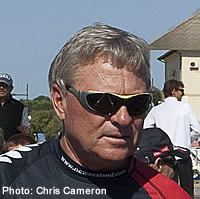 Rod Davis
Rod Davis
Another legend in the sport is Kiwi-ised American Rod Davis, who’s first Cup was back in 1977. In the ACC era he helmed New Zealand Challenge in 1992 and then OneAustralia before two campaigns with Prada. Today he is the much respected coach for Emirates Team New Zealand.
Davis believes heavy boats are a dying breed, but do ACC boats require more skills to sail than faster boats? “From the crew standpoint, these boats are more challenging than a TP52 because they have a spinnaker pole and the sails are bigger. Physically they are much more demanding with an overlapping jib than a little TP52 jib, which is a couple of turns on the handle and that’s it, done. These boats from a crew standpoint are much more demanding even if you blew the TP52 up to the same size, but the overlapping jib isn’t as good from a pure efficiency standpoint. These boats go very fast upwind. They are designed to do that and that is where most America’s Cups are won or lost. They are very efficient there. They are not as efficient downwind as you could make them.
“They are a very physical boat to sail in 18+ knots of breeze. That is why the crews like them, because they can get stuck into them real hard, it is not a real fine finesse, it is about who can out-grunt who, and it is a very physical contest – tacking and manoeuvring.”
Happy with the change to cats? “The jury is still out on that one. I think most people would have preferred to go into big monohulls that were lighter and faster and stuff. The catamaran is a radical departure. We don’t think about whether it is good, bad or indifferent. Someone else calls the tune, we just do the dancing.
“I think is going to be fun, because I think we can figure it out as well as anybody. So we are not intimidated by it in any way. They figured it out, we can figure it out. I think in some ways I think it is going to be great. I am glad we are going to be out of these boats. I have tons and tons of notebooks – really we have learned most of what we need to learn about these boats.”
What will happen to all the ACC boats? “Take them out to the desert and leave them there. They are a liability.”
ACC can certainly be picked up very very cheaply right now. But what would you use one for?








Latest Comments
waylandsailor 03/12/2010 - 19:17
I'm sooo old. My first race boat had a blooper and we had fun sailing downwind in heavy air with spinnaker and blooper (a cheater nylon genoa that flew to leeward of the spinnaker) because the pinched stern IOR (you kids do not know what that was either) boats would spin out on a heavy air run. Don MitchellAdd a comment - Members log in